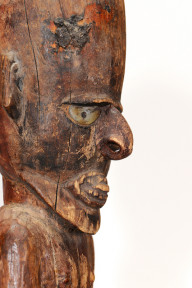Lot #9219 - A Rare Mundugumor Figure, Yuat River, Sepik Region, Papua New Guinea
-
Auction House:Theodore Bruce
-
Sale Name:Aboriginal, Oceanic & Tribal Art
-
Sale Date:07 Dec 2020 ~ 6pm (AEDT)
-
Lot #:9219
-
Lot Description:A Rare Mundugumor Figure, Yuat River, Sepik Region, Papua New Guinea
Condition report: age crack to back of head left side abdomen; marks on torso as per image; arms appear to have a peg or nail in centre of bicep; faded ochre colour has areas of wear. PROVENANCE: Ex collection of Harold Woodman (1892-1974), a government patrol officer in the Sepik District during the 1920s and 1930s (Gash & Whittaker 1975, Plates 474, 588-590). In 1940 he was recalled to the military with a rank of Lieutenant-Colonel for the duration of World War II. Following the war he returned to New Guinea as District Officer at Madang. Upon retirement he lived in Sydney. In 1958 Woodman sold his collection, including this piece, to Eugene van Grecken, of Sydney. In 1966 Jean Guiart purchased a group of items from Van Grecken, including two from the Colonel Woodman Collection, for the National Museum of the Arts of Africa and Oceania, France, now incorporated into the Musee du Quai Branly in Paris. There remains a degree controversy about some of these items (Beran, 2016, p. 179), although that is not the case with this figure.Thence by descent to the Khan van Grecken Collection, New South Wales.
H: 52.5 cm -
Notes:This wood male figure appears, from the photographs I have been sent, to have been carved by a man from the middle Yuat River, perhaps in the vicinity of Biwat and therefore of the so-called Mundugumor people. Margaret Mead and Leo Fortune, in 1932, were the first anthropologists to do research among the Mundugumor. Mundugumor flute stoppers are to be found illustrated in several publications and Mead did provide some information about these (Mead 1934:238) but her published information about carved figures and masks is sketchy. Several figures such as those photographed and collected during the 1935 voyage of La Korrigane (Coiffier 2001) appear to be roof finials, with a hollowed-out base (see the Berlin example in Kelm 1968, Plate 20) like those of the Iatmul. Although there were no permanent cult houses to which they could have been attached, it is possible they were attached to the temporary initiation or seclusion houses and moved back to storage in family dwellings afterwards. This figure however does not appear to be one of those. It has a flat base, not hollowed out like the so-called finials (there appears to have been some restoration work done on the base and around the feet). Its significance and function are not known. The figure incorporates characteristics of figures from various locations in the Yuat River area. Its stance from shoulders to feet, like that of the Berlin 'finial', is like those of the Mekmek speakers to the west (Craig, Vanderwal & Winter 2015, Figs 3.125, 126): the arms hang straight from the shoulders, not touching the hips, the fingers carved perfunctorily; the navel is indicated by a small design; the knees and ankle bones also are indicated. The head has the high domed forehead and semi-circular shell eyes of the Mundugumor flute stoppers, but the mouth is open showing the teeth and a protruding tongue which, in 1981, I observed on masks and on the heads of figures and slit gongs at Asangamut (Miyak speakers) on the upper Yuat and at Bun (Bun speakers) upstream from the Mundugumor (Biwat speakers). There appear to be remnants of mastic on the head, presumably (originally) for fastening cassowary feathers like those found on the flute stoppers. If we accept the information that the figure was collected in the 1920s by Harold Woodman, the condition of the figure indicates that it must have been carved some time in the 19th century. Barry Craig. References: Beran, H. 2016. Nineteen "New Guinea" sculptures by a mystery hoaxer from the Gene van Grecken Collection. Journal de la Societe des Oceanistes 142-143, 2016, pp. 179-192. Coiffier, C. 2001. Le voyage de la Korrigane dans les mers du Sud. Paris: Éditions Hazan, Musée de l'Homme. Craig, B., R. Vanderwal and C. Winter. 2015. War Trophies of Curios? The War Museum Collection in Museum Victoria 1915-1920. Melbourne: Museum Victoria Publishing. Gash, N and J. Whittaker. 1875. A Pictorial History of New Guinea. Milton, Qld: Jacaranda Press. Kelm, H. 1968. Kunst vom Sepik III. Berlin: Museum für Völkerkunde. Mead, M. 1934. Tamberans and Tumbuans in New Guinea. Natural History 34:234-246. Wardwell, A. 1994. Island Ancestors. Oceanic Art from the Masco Collection. University of Washington Press in association with the Detroit Institute of Arts
-
Estimate:A$60,000 - 80,000
-
Realised Price:$0.00
-
Category:Tribal
This Sale has been held and this item is no longer available. Details are provided for information purposes only.










